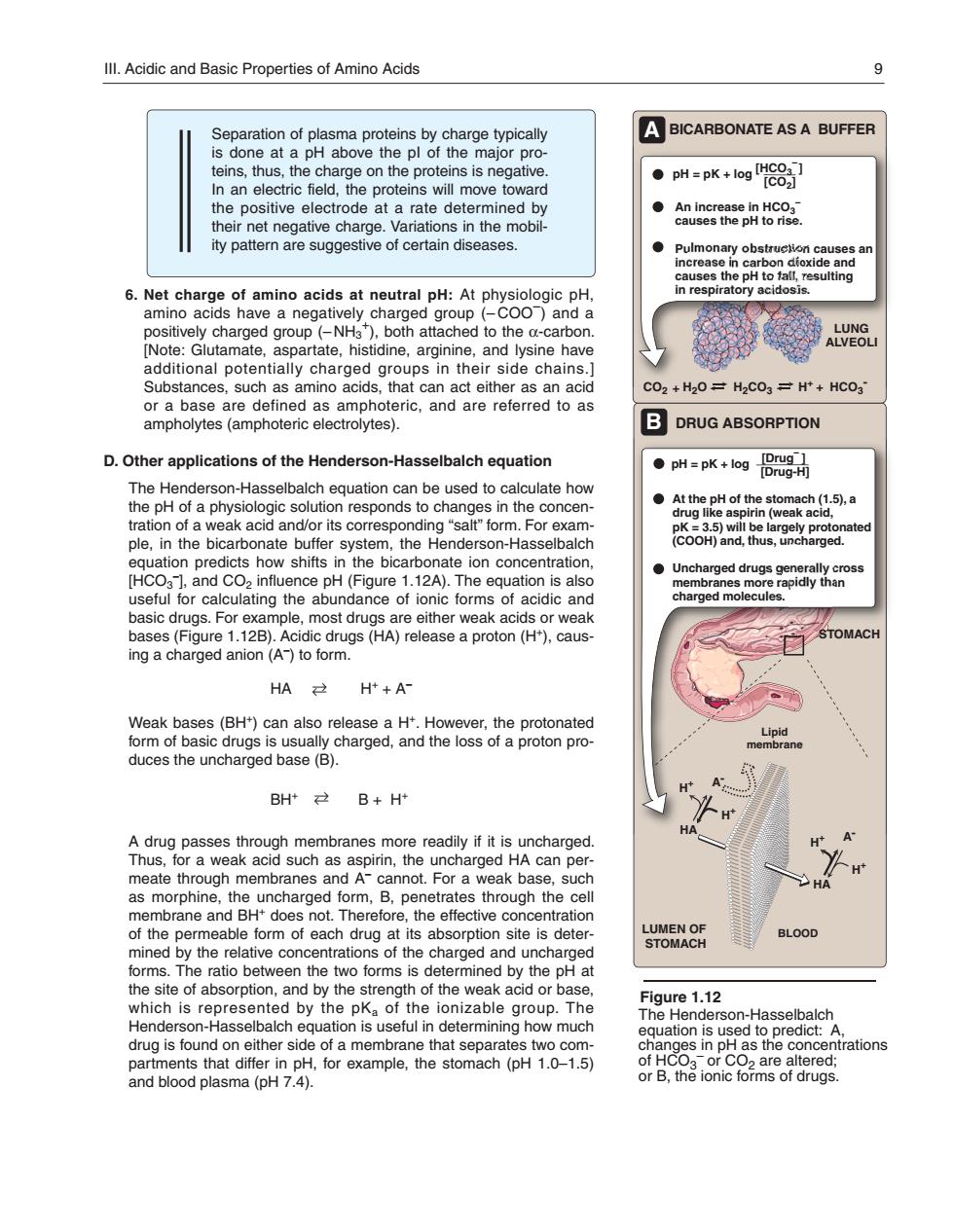正在加载图片...

II.Acidic and Basic Properties of Amino Acids Separation of plasma proteins by charge typically ABICARBONATE AS A BUFFER ●pH=pK+ogH8 the positive electrode at a rate determined by ·& ty pattern are suggestiv ● in respiratory acidos QereLhaegropHbothanachediotheacaton additional pochains. entially charo C02+H20=H2C03=H+HC03 or a base are defined as amphoteric,and are referred to as ampholytes (amphoteric electrolytes) BDRUG ABSORPTION D.Other applications of the Henderson-Hasselbalch equation ●pH=pk+log8gh me p dc now ●&,a ple,in the bicarbonate buffer system the Henderson-Hasselbalch 9Cotioneihoshtsnhebcatonaeonconcentalion The eque asic drugs.For example.most drugs are either weak acids or weak bases(Figure 1.12B).Acidic drugs(HA)release a proton(H*),caus- OMAC ing a charged anion(A)to form HA2 H*+A- Weak bases (BH')can also release a H'.However.the protonated form of basic drugs is usually charged,and the loss of a proton pro- duces the uncharged base (B) BH2 B+H d ncha meate through membranes and A-cannot.For a weak base.such as morphine.the uncharged orm.B. ates through the cell he effec ve c BLOO mined by the relative concentrations of the charged and uncharged forms.The ratio between the two forms is determined by the pH at the site of nd by the stre gth of the wea acid or 1.12 The ure nde -Hasselbalch drug is found on either side of a membrane that separates two com- s in ot HCO trations H,for example,the stomach (pH 1.0-1.5) 4. or B.the ionic forms of drugs.Separation of plasma proteins by charge typically is done at a pH above the pI of the major proteins, thus, the charge on the proteins is negative. In an electric field, the proteins will move toward the positive electrode at a rate determined by their net negative charge. Variations in the mobility pattern are suggestive of certain diseases. 6. Net charge of amino acids at neutral pH: At physiologic pH, amino acids have a negatively charged group (– COO–) and a positively charged group (– NH3 +), both attached to the α-carbon. [Note: Glutamate, aspartate, histidine, arginine, and lysine have additional potentially charged groups in their side chains.] Substances, such as amino acids, that can act either as an acid or a base are defined as amphoteric, and are referred to as ampholytes (amphoteric electrolytes). D. Other applications of the Henderson-Hasselbalch equation The Henderson-Hasselbalch equation can be used to calculate how the pH of a physiologic solution responds to changes in the concentration of a weak acid and/or its corresponding “salt” form. For example, in the bicarbonate buffer system, the Henderson-Hasselbalch equation predicts how shifts in the bicarbonate ion concentration, [HCO3 – ], and CO2 influence pH (Figure 1.12A). The equation is also useful for calculating the abundance of ionic forms of acidic and basic drugs. For example, most drugs are either weak acids or weak bases (Figure 1.12B). Acidic drugs (HA) release a proton (H+), causing a charged anion (A– ) to form. HA H+ + A– Weak bases (BH+) can also release a H+. However, the protonated form of basic drugs is usually charged, and the loss of a proton produces the uncharged base (B). BH+ B + H+ A drug passes through membranes more readily if it is uncharged. Thus, for a weak acid such as aspirin, the uncharged HA can permeate through membranes and A– cannot. For a weak base, such as morphine, the uncharged form, B, penetrates through the cell membrane and BH+ does not. Therefore, the effective concentration of the permeable form of each drug at its absorption site is determined by the relative concentrations of the charged and uncharged forms. The ratio between the two forms is determined by the pH at the site of absorption, and by the strength of the weak acid or base, which is represented by the pKa of the ionizable group. The Henderson-Hasselbalch equation is useful in determining how much drug is found on either side of a membrane that separates two compartments that differ in pH, for example, the stomach (pH 1.0–1.5) and blood plasma (pH 7.4). →← →← Figure 1.12 The Henderson-Hasselbalch equation is used to predict: A, changes in pH as the concentrations of HCO3 – or CO2 are altered; or B, the ionic forms of drugs. H2CO3 HCO3 - H+ CO2 + H2O + BICARBONATE AS A BUFFER An increase in HCO3 – causes the pH to rise. Pulmonary obstruction causes an increase in carbon dioxide and causes the pH to fall, resulting in respiratory acidosis. pH = pK + log [HCO3 – ] [CO2] DRUG ABSORPTION At the pH of the stomach (1.5), a drug like aspirin (weak acid, pK = 3.5) will be largely protonated (COOH) and, thus, uncharged. Uncharged drugs generally cross membranes more rapidly than charged molecules. pH = pK + log [Drug-H] [Drug– ] A B A HA - Lipid membrane LUMEN OF STOMACH STOMACH LUNG ALVEOLI BLOOD H+ H+ H+ A HA - H+ III. Acidic and Basic Properties of Amino Acids 9 168397_P001-012.qxd7.0:02 Protein structure 5-20-04 2010.4.4 9:45 AM Page 9